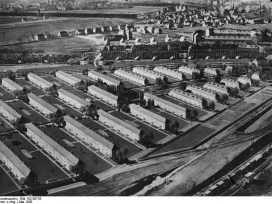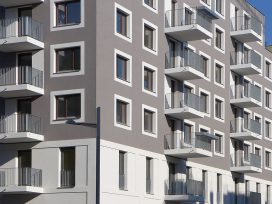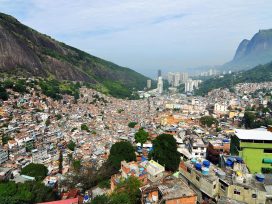The “network within the network” is the catchy name the Hamburg city transport company, the Hamburger Verkehrsverbund (HVV), has for its two-dozen bus routes connecting the city centre with the outer districts. A friend of mine calls them something else: the “lines of destiny”. In particular he means the number 3. It starts in the prestigious HafenCity, crosses the city centre, snakes its way along the border of the trendy Schanze and St. Pauli districts and clips the corner of the gentrified Altona. From there it crosses working-class Bahrenfeld, passes the high-rise estate at Osdorfer Born and ends up in the village atmosphere of Schenefeld.
I often find myself riding the number 3, since it links my home to where I work and to where I’m involved in urban activism. Is it chance or social class that determines where one gets on and off the bus? How are the stops really connected? How does civic space create social structure, and how does social structure create civic space? These questions occupy me not just on my bus rides but also in the context of “Right to the City” (Recht auf Stadt). In the three years of its existence in Hamburg, the network’s actions and initiatives have managed to attract considerable attention. Its slogans, visible everywhere around town, are the most conspicuous signs of protest against the sell-out of a city. So it’s high time to get off the bus and take a look around. In the last few weeks I’ve made repeated journeys on the number 3, my luggage packed with questions, meeting people from various civic initiatives based along its route.
Born on the edge: Of peripheries and centres
But let’s start at the so-called periphery, where there is no active campaign group. I would have normally have got off the bus long before it reaches Osdorfer Born. Located on Hamburg’s western fringe, the high-rise estate was built in 1972 according to the principle of “urbanity and high-density living”. Today, over 10,000 people live in an area covering less than one square kilometre. The estate can only be reached by bus, since every time the city council has to decide whether to connect it to the S-Bahn light rail network, they run out of money or motivation. A poor public transport connection is a fate that Osdorfer Born shares with other estates in Hamburg.
It’s often the most densely populated areas of a city that are only served by bus, and where peoples’ journey downtown to work takes the longest. The “right to the city” – as conceived by Henri Lefebvre, the inventor of the concept – always entails the right to central places, to equal access to a city’s political, cultural and social resources. This is why campaigns for a well-connected, free public transport system are so hugely important: it precisely here that non-hierarchical access to the city’s resources happens. In Hamburg this initiative is called “HVV for free”.

“The paint peeled from the facades of the high-rises long ago and now they are a drab grey, like everything else here.” Journalists always use some such formula to set the scene on the estate, as in a feature in the Hamburger Abendblatt portraying a “vicar in the problem district” who “refuses to let things get him down”. I also remain upbeat as I stroll past the looming tower blocks, see a barred-up underground car park, talk to two Ukrainian women wearing floral headscarves; I get in a lift that takes me up 23 storeys and stare out over the city-scape below. When I look, I see through the eyes of a tourist. It is precisely this way of looking at the supposed “other”, at what is excluded from the city but nevertheless belongs, that troubles me.
There have been numerous analyses of the Right to the City movement, and practically every one makes the same criticism: that those who are truly marginalized (benefits claimants, migrants, the residents of the city’s fringes) are not represented in the protests. The criticisms tend to be justified. Protest does indeed focus on the city centre, which is where most of the activists live. The vast majority are highly educated and middle-class, have good connections and are well-informed, but are often themselves in poorly paid work.
The whole question of who we represent has accompanied Right to the City from the start. We don’t want to channel other voices. Shaping the city oneself means taking action oneself, rather than teaching others to be activists. The network has grown steadily in recent years, as more and more initiatives addressing various conflicts join up. There is an abstract consensus among them all that the city is a collective entity. What connects us is Lefebvre’s concept of the city as place of “concentrated difference”, a place that belongs to everyone and that everyone can shape – regardless of what they stand for, what they own or how much they earn.
What was new about the network that took shape under the RAS umbrella was the wide variety of initiatives: climate activists fighting plans to build a district heating plant meet allotment-holders threatened with eviction and creative artists protesting being used as a selling point for the city. Then there are the squatters, the tenants’ associations and the citizens who propose alternatives to the city’s big image projects and the privatization of public utilities. At monthly meetings, all members of the network report on their activities and plan joint actions. Despite the thematic variety, however, the movement remains fairly uniform. This isn’t the case with the Right to the City movements in North and South America, where homeless people have become activists alongside the urban poor and members of other marginalized groups. Obviously, something about the way that protest is organized in Hamburg can also shut people out.
“In a hierarchical society there is no space that is not organized hierarchically”, wrote Pierre Bourdieu, pointing out that social questions are always spatially inscribed. Where architecture is hostile or where a district is cut off from the city’s infrastructure, this always serves to keep people in their place. Social space can create powerlessness. I stand in front of the “Born Center”, a busy shopping mall, and wait for the number 3. A few people are gathering in front of a snack bar, one of the places here where you can hang around as long as you want. “Born on the road. Osdorfer Born joins the scene”: a flyposter stuck up near the bus stop is announcing a local street festival. Here, “the scene” isn’t yet synonymous for rising rents – like elsewhere in Hamburg. Rather, it stands for the desire to play a part.
The Bahrenfeld racetrack: We’re building a new city
At the entrance to the racetrack at Bahrenfeld I’m handed a free sheet called Racer’s World. It’s a guidebook to a place that is, indeed, almost a world of its own. Bahrenfeld is a venue for harness racing, where the driver sits behind the horse on a light buggy (the trap). The venue’s slogan is “where winners meet”, but this can’t disguise the fact that the racetrack left its glory days behind more than a hundred years ago. The first race is in half an hour. I put five euros on Bertie, who Racer’s World tips as a fast runner though rather high-strung. More and more people wander in, but you could hardly call it a crowd. One of the trap drivers, who is getting on in years, is asked “Haven’t you retired yet?” He laughs and shrugs. He’ll have to retire soon though, at least from racing here. The Social Democrats, who have led the majority government in the city since 2011, are planning to demolish the racetrack to make way for housing. One more quirky place that will vanish. Bertie can’t do anything to change that either, although he finishes second and makes me 2.50 euros richer by the time I leave.

A couple of days later I meet Ralf Hendel, spokesperson for the campaign group “Trees with fruits need room for roots”. This group of allotment gardeners have long challenged the council’s urban design plans, since it’s not just the racetrack that’s due for demolition but also their allotment space and city parkland. The government’s project is called the Bahrenfeld Nord Framework Plan. The main feature is the widening of the A7 motorway from six lanes to eight. Two arguments are used to sell this transport project: that it will create housing, and that the motorway will be roofed over to prevent noise pollution. Certainly, both are urgently needed. There’s a critical shortage of housing in Hamburg; conservative estimates say that a further 60,000 flats or homes are needed. There’s also a crisis in the Hamburg’s transport infrastructure; in Bahrenfeld, one of the city’s motorway exits, the roar of traffic is inescapable.
So what’s the problem? After all, one of Right to the City’s central demands is affordable living space. It’s undoubtedly been one of the movement’s biggest successes to have pushed the topic up the political agenda; for years, the city’s housing master plan was utterly neglected. Now the council wants to make up for lost time at breakneck speed. The Hamburg tenants’ association, which tends to be a conservative voice in such matters, has encouraged the council, saying that, “if house-building is the most important thing, then it must take precedence over citizen consultation and conservation.”
“Ecological issues shouldn’t be pitted against the house-building agenda, but that’s exactly what’s happening,” says Ralf Hendel. “Quality of life sinks dramatically when there’s no green space in the city, and our allotments also serve as green lungs for the urban micro-climate.” He’s equally sceptical about the social housing that’s supposedly going to be built here. If you look at where exactly the social housing is to be built, he says, it’s clearly a fig leaf for the rest. “These are going to be buffer-zone buildings looking out directly onto one of the busiest roads. They’re meant to provide sound insulation for the developments behind – yes, people will live there, but they’ve been brought in to boost the prices of private housing in the quieter areas.” Many of the allotment holders are worried that they will be evicted from their gardens and the motorway will be widened, but that there’ll be no money left to roof it over. The result would be more traffic, more noise and less green space. A socially just and sustainable concept for the city would have to declare war on the car, a highly subsidized, climate-killing form of individual mobility. In Germany, where the car lobby is so powerful, that would amount to a revolution.
Kaltenkirchener Platz: The new spirit of participation
One of the most common criticisms of Right to the City is that “all it ever does is oppose”. It’s true, every participant starts by saying no to something – no, we don’t want to be governed this way; no, we don’t want another city-branding project that enriches a handful while the losses are spread across the board. Yet this collective “No” shouldn’t be understood as a “No” to change in general. Relations and networks in the city are constantly altering and differences and contrasts are what make up the very stuff of urban life. By contrast, it’s the neoliberal city that wants stasis; that plans to steamroll all these differences with its dreams of value appreciation. The Frankfurt-based campaign group Kulturcampus describes this very well in a short manifesto: “All of a sudden the city stopped moving. It became property.”
My next destination is another place that says “No” loud and clear. No to the top-down hegemony of planning culture. From the bus stop I walk past abandoned railway track, on my left small businesses and workshops, on my right housing and a brewery warehouse. This is where I meet Thomas Leske. We’re in the middle of Altopia – derived from Altona, the name of the district. It’s what the Altopia campaign group calls the area. The city council calls it New City Centre Altona – the basic shape of the conflict already becomes apparent. Will Altona become a new city centre? Can citizen participation create something really new here, or will it be turned into yet another investor-friendly ghetto for property portfolio-holders?

The argument is over 75 hectares of inner-city land – if the current railway terminal is moved elsewhere, which German Railways has not yet decided. The city government promises that the district will become “a vibrant, family-friendly residential quarter with around 3,500 homes”. The land is already mostly privately owned by global players like Bahn AG, Aurealis Real Estate and the shopping-centre developers ECE. But though the city doesn’t own the land, city government has considerable power to decide how the master plan is to be developed, how plots may be leased and built, and what the building mix should be. The city also has a right of compulsory purchase on the area if the owners are found not to be acting in the civic interest.
But this is exactly where the disagreements lie – what is the civic interest? The council is arguing strongly for a “mix of thirds”; one third privately-owned housing, one third rental housing with market rate leases, and one third social housing where rents are subsidized to a fixed rate for fifteen years. Altopia calls it gentrification by fiat and is arguing instead for a liveable mixture. “What we mean,” Leske explains, “is that the social mix in the districts round about should also be reflected in the new development.” The campaign group is demanding a mix of 30 per cent small business with 70 per cent cooperative housing, half of which should be social housing. They want additional guarantees of 80 per cent car-free areas and a 40 per cent migrant population. This could work out cheaper for the city by creating a socially balanced district that functions well in the long run, as part of a sustainable urban development policy.
What is certain is that, ever since the mass protests in Stuttgart over the new railway station, mega-projects simply can’t be planned in secret. The new spirit of city planning goes through the motions of citizen consultation with much fanfare, while offering no real guarantees. Residents can speak their mind at various events and there’s an info-centre where you can write down concerns and pin them to the board. Mediators have been employed to conduct “dialogic interviews” with planning departments, residents, campaign groups, small businesses and investors. A detailed citizens’ assessment report on the master plan has resulted in suggestions for change and improvement – not one of which has actually been adopted. A citizens’ committee has been formed that has no actual voting rights. It has unanimously called for an immediate planning stop, saying that the whole process has been too hasty and that the council has not acted with sufficient transparency. However, all the indications are that the master plan will be approved. “There’s been no participation in the true sense of the word,” says Leske of the city government’s information services. “So far this has been games for grownups with no decision-making power.”
Feldstraße: Self-organization needs space
“We must reclaim our right to the city,” says the Marxist geographer David Harvey, and in particular he means from those realizing their shiny new vision of a steel-and-glass city aimed solely at profit maximization. What vanishes are the places that don’t pay their way, but are very valuable indeed to those who need them. These are the blind corners on the game board of the city, the empty lots gone to seed, the heterogeneous city quarters, the public spaces where people don’t need to spend and consume.
The new hoarding at the bus stop at Feldstraße exemplifies exactly the shiny version of profit interest that Harvey describes. The fence closes off the huge site of the old cattle market to any resident-centred, small-scale planning options. Instead, a mock historic façade is under construction that will soon house a hypermarket. “Beacon of defeated participation” it says, in large letters on the hoarding – posted there by a coalition of local campaign groups calling itself “Our Site”. The plot, with its 14,000 square metre hangar, has been standing vacant for the last three years, during which time campaigners have been fighting against top-down planning, using various tactics to bring self-organized planning culture to the site. But instead of adopting any of their proposals, the owners have persuaded the city council that there are “practical limitations”. The site has now been leased indefinitely to a retail chain and the alternative proposals seem doomed to gather dust.

Across the street I meet a woman who is an old hand at “reclaiming the space” – Tina Fritsche. We’re standing in front of the Centro Sociale neighbourhood centre, which aims to serve as a “counterpoint to gentrification”. It has been something of a germination chamber for the Hamburg Right to the City movement: this is where the founding meeting took place in 2009, with about a dozen campaign groups and a hundred people present. It’s a self-administered space, clawed back from city council with a mix of charm and bloody-mindedness – albeit for a painfully high rent. The entrance hall is plastered over with three years’ worth of Right to the Cirty; posters publicizing demos against empty housing and rising rents, invitations to the international Right to the City Congress, posters from the campaign group No BNQ, seeking to stop the gentrification of St. Pauli, classics such as the poster “Let red roses rain down on you”, in solidarity with the Rote Flora collective, who have been squatting an abandoned theatre in the Schanzenviertel for the past thirteen years.
Tina Fritsche remembers the first meetings of Right to the City. “We’ve always said that a city is a place of concentrated difference, and especially in the early days we needed to be very careful to bring all these different strands into one network, to respect them on their own terms.” Such a working relationship isn’t always easy. Particularly, there are fierce disagreements over the question of “how green the city should be versus how urban it must be”. How can concentrated housing combine social justice with the preservation of natural resources and shared space? The daily newspaper taz summed up the new network under the headline “Green fingers and black bloc”. “The real strength of Recht auf Stadt is that so many groups are able tie their particular campaigns to our network,” Fritsche says. “The fact that we can’t be lumped together outwardly also gives us more manoeuverability.”
Johannes-Brahms-Platz: A tale of two cities
The next stop is Bäckerbreitergang, an alley wedged in between the district prosecutor’s offices, the headquarters of the Bild newspaper and glass-fronted luxury apartment blocks with expensive boutiques. It is a last remnant of the narrow, winding streets of old Hamburg, the “gangs”. At the end of Bäckerbreitergang is a blaze of colour; a neon-yellow façade with huge green polka dots shines out from behind scaffolding. Welcome to the Gängeviertel, probably the best-known symbol of Hamburg’s resistance to neoliberal urban planning. It’s made up of twelve buildings whose fate seemed to have been sealed when 80 per cent were consigned for demolition and the rest, those with listed status, singled out for lavish restoration. A Dutch investor had bought the buildings from city government cheaply, the council having neglected this part of the city’s heritage for years. By 2002 most leaseholders had moved out and the city’s housing authority was just sitting back watching the place fall to ruin so that it could argue that the property had to be sold on.
Business as usual, you might think. Except that, one day, artists and performers, political activists and local residents came to the gangs. On 22 August 2009 they took over the buildings in an “art-coup” and found the doors wide open. The whole complex was proclaimed an exhibition space, artworks were put up and a street party was held. The occupation sparked off a vigorous discussion about the forms that resistance can take and how politics and art interact. The movement’s sympathizers ranged from cultural workers and arts patrons to shopkeepers and conservative readers of the Hamburger Abendblatt. In the following weeks, thousands of visitors came to look, to party and to talk. The crazy mix of how the space was used and the feeling that, all of a sudden, things were possible, gave the beginning of the movement an enormous utopian potential: what if…

When people claim their right to the city, it’s always through an act of occupation and emancipation. In recent decades, a massive political programme of redistribution has taken place in cities, from the bottom to the top. Political leadership has been selling off city-owned property on a grand scale – public utilities, energy corporations, transport networks, real estate, land – and pressuring city-owned bodies to turn a profit. Hamburg’s property-holding SAGA GWG has been told to achieve the impossible by providing affordable housing while bringing in an annual 100 million euro to the public coffers.
After immense public pressure, the city eventually bought back the Gängeviertel buildings from the investor for 2.8 million euros. This was a huge success for the RAS at a very fortunate moment. It was a real headache for the Greens that they had chosen the “creative city” as one of their slogans, only to see the artists break free from their embrace and rebel. The story may not mark a reversal in the politics of urban development, but the campaign’s success suggests that the threat of loss of image is the authorities’ Achilles’ heel. But the fight isn’t over; the buildings badly need restoration and arguments continue over how much autonomy of use residents will enjoy.
The Marco Polo Waterfront: Hamburg City plc. in financial straits
From the Gängeviertel, I take the number 3 through the city centre, where only about 5000 people actually live. Most people come here either to work or to consume: life is elsewhere. Centrality is not necessarily a fixed feature of a city. “Anywhere can become a flashpoint, the privileged position where all lines converge,” Lefebvre writes in La révolution urbaine. A mobile market-square or, rather, numerous different centres, moving from place to place, where the unpredictable can claim a place at any time: “But even as it takes shape, the concentrated energies dissipate once more, fray apart. Another centre is required, a periphery, a somewhere-else-again.”
This is a wildly optimistic view of things, I think, as I ride south of the city centre, and not just with regard to the HafenCity. Here, at the “showcase project for international waterfront and New Downtown development”, is where the bus ends. According to its public relations portal, the HafenCity project aims to be nothing less than “a model for the development of the European city in the twenty-first century”. By 2025 there will be a whole new district in the former harbour, expanding Hamburg’s city centre by 30 per cent. Today, it’s still oppressively empty in the freshly installed shopping arcades. There have already been plenty of conflicts around which resistance could take shape. HafenCity was planned behind closed doors and is deeply socially imbalanced. There has been a string of striking planning failures, for instance the 50,000 square metres of vacant space in the Überseeviertel, where, having attracted investors by guaranteeing fixed revenues, the city council now has to pay the astronomical rent itself. There has also been criticism of the nondescript, hulking architecture and the transport concept, a throwback to the days of underground car parks and subway connections with runaway costs. Unlike in Osdorfer Born, no expense has been spared to assure that HafenCity – an area at constant risk of flooding – has a transport link below the waterline. The icing on the cake is the Elbphilharmonie concert hall, a flagship project that has already cost the city half a billion euros.
Despite all this, nobody from Right to the City is active here whom I could meet. In the mixed district of St. Pauli, a disproportionate number of people get involved on behalf of their borough, yet here huge sums of city money have been squandered to very little protest. It seems that when conflict and confrontation take shape around particular places, as is the case for Right to the City, this always has something to do with identification. Working-class and red-light romanticism notwithstanding, St. Pauli is a district where the city’s genealogy is visible in the architecture and in the social mix. A place that works because it is so heterogeneous, in a way that the rapidly erected HafenCity can only dream of. There was nobody living here who could have opposed the planning, and the few small demonstrations that did take place were drowned out by the city’s image campaign.

With my back to the Marco Polo Tower, I look out southwards over the Elbe. This is where city government plans to conquer new land, colonial-style. “The leap over the Elbe”, as they call it, is one of their central projects for a “growing city”, whose highlights in 2013 will be the International Architecture Exhibition and the International Garden Show. Yet the new land they want to claim is by no means empty. Around 50,000 people live on the islands in the river, Wilhelmsburg and Veddel. For years, many of them have been calling for a development plan for their neighbourhood, but not for an advertising machine to attract investors, which is what has now happened. Various people from the Elbe islands have become active in Right to the City. Even if we can’t prevent the government from leaping over the Elbe, we can make sure that they land with a bump.
“Born on the road”. On the bus ride home, I keep thinking of the slogan of Osdorfer Born. The story has it that Lefebvre developed his theories of the right to the city during his commute between Paris and the satellite town of Nanterre, ten kilometres away, where he taught sociology in the mid-1960s. At the time, the university and the office blocks of La Défense were being built there at breakneck speed. Nanterre was one gigantic construction site. It was on this university campus, so different – and not just architecturally – from the elite Sorbonne, that the protests of 1968 began. The occupation of the university administration on 22 March 1968 was the spark that lit the flames, and only then did the fire spread from the periphery to the centre, the Sorbonne.













